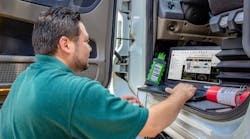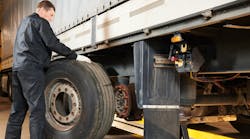In October 2018, Peterbilt introduced a vehicle electronic control unit, or VECU, which now comes standard for all Model 567 vocational trucks and Model 579 on-highway trucks, equipped with Paccar MX Series engines and Cummins engines. The VECU was originally introduced as a means to simplify truck body upfitting – a critical element designed to help streamline vocational truck spec'ing. But, there’s more to the VECU’s story, according to Peterbilt’s Engine Integration Engineer, Taylor Griffin.
During a recent vocational dealer event in Gateway, Colorado, Griffin shared insights on what having the VECU-equipped on Peterbilt Model 567 and Model 579 trucks means for future vehicle integration, remote diagnostics, and the handling of data coming off the vehicles.
Built for the future
Griffin works out of the Paccar Technical Center in Mount Vernon, Washington. His focus now is on the vocational market, but much of the technology Griffin discussed is applicable to both the 567 vocational models and the 579 on-highway trucks. He recently took a lead role in managing the process for vehicle software development and calibration adjustments for Peterbilt. Calibration is the ease and accuracy with which vehicle system controllers – such as those that monitor and control the engine, or the anti-lock braking system – communicate with one another.
“The VECU is the main vehicle controller that coordinates everything,” Griffin explains. “It’s the overarching lead computer for the entire truck.”
The VECU is the central system, or “brain” of the vehicle, which coordinates the input of data from all of the other electronic control units, or ECUs, on the vehicle, including the cab controller, transmission controller, ABS controller, and others, if equipped.
The VECU was developed for the inevitable growth of the amount of data created and the quickness with which that additional data must be transferred.
“What we were running into is [the company] keeps wanting to add more and more advanced functions and safety features to the vehicles, and the current architecture [was] too full, it didn’t have room for the expansion,” Griffin says. “Since we’ve introduced the VECU, we have room for continued growth. We have things we want to be able to do on the truck in the future for functionality and safety, that our customers expect. The VECU gives us room to grow.”
Impact on diagnostic tooling
The VECU also provides additional functions and features for fleets, especially as it relates to diagnostics, Griffin says. Technicians servicing a Peterbilt with a Paccar engine would use the DAVIE diagnostic and programming tool, just as they have for previous generations of vehicles.
“Now DAVIE is the diagnostic and programming tool for the engine, the VECU, and several of our Eaton transmissions as well,” Griffin says. “We’re trying to integrate towards a one-tool system for the entire truck, so the tech doesn’t have to have six or seven different software [programs] on his computer, he can do it all through the one tool.”
With the introduction of the VECU, technicians still use a 9-pin adapter but must use adapters meeting the criteria of the J1939-2 standard. This means shops must use the updated green pinout adapter, an upgrade from the original J1939-1 9-pin adapter.
When it comes to remote diagnostics and vehicle monitoring, Peterbilt’s SmartLINQ telematics system bridges the gap between the service bay tool and vehicle system monitoring while the truck is out on the job site or over the road.
“They are separate [tools], but utilized together,” Griffin said of the DAVIES diagnostic tool and SmartLINQ telematics system. “When the [SmartLINQ] remote diagnostics would indicate a problem or detects an issue, the truck would come into a service center. Or if you’re a fleet manager and have DAVIE yourself, the vehicle would come in, you would use DAVIE to identify, troubleshoot, and correct the issue.”
Griffin confirmed the introduction of the VECU has allowed the Peterbilt team to continue focusing on improving features and functionality for customers, including the progression of remote diagnostics and beyond. Currently, that starts and ends with engine data.
“At this time, it is just engine codes, but there are plans to continue to grow that for other systems and other faults on the truck as well,” Griffin says. “Customers want to know what’s going on throughout the entire truck, not just the engine. I’ve heard that feedback with customers. We are looking to grow in that direction.”
Comparisons to automotive
The vehicle’s CAN bus network is the method with which vehicle system controllers are able to communicate with one another.
"The VCAN-2 is the primary CAN for the vehicle controllers and is not intended for direct customer access," explains Griffin. "To provide customers the CAN access they require, Paccar created several customer-facing CANs. These customer-facing CANs can be accessed at multiple locations on the truck and at the industry standard baud rates of 250 kilobytes per second (kb/s) and 500 kilobytes per second." These customer-facing CANs are also where fleets can connect for electronic logging device (ELD) information or body controllers.
But, as the data transferred between these systems continues to grow, it will require a rethinking of methods for transferring this data between vehicle controllers in a timely manner. The industry has looked at methods beyond the traditional CAN bus system, with updates that allow for faster transfer of data, such as CAN-FD (flexible data-rate) and CAN-XL. Further out, the trucking industry may look to options such as ethernet to replace the CAN bus system altogether. While it may be a long-term solution for the commercial vehicle industry, ethernet is only now in the early stages of being built into passenger vehicles.
“The CAN networks will – at some point – get to their limits of how much communication [they can transfer], and how quickly they can communicate it at a high fidelity,” Griffin says. “That’s why a lot of automotive companies have moved toward ethernet, to communicate much more data, much faster. There is a big architectural change that has to be made to step up to that, and a big electrical change with that as well. It’s not something that we’re looking at in the near future.”
There are often comparisons made between the passenger vehicle market and the commercial truck market. As technological advancements continue, the transportation industry may see that gap continues to close as commercial vehicle technology catches up to automotive technology.
“You do see the trucking industry does seem to trail behind the automotive industry [with some technologies],” Griffin adds. “The gap there is getting smaller and smaller. People that are driving those new cars with all those features and functions will ask ‘Why doesn’t my semi have lane detection or lane holding, cruise control?’ They are starting to push, and we are starting to see that more. I think that trend will continue. We’ll be behind the automotive industry. But as they progress, we’ll progress.”
The rapid pace at which both industries have moved concurrently can be attributed to the amount of data created from the vehicles and the usage of those vehicles.
“There’s so much data coming from these things,” Griffin says. “It’s how best to utilize it, the customer functions, and the features they need and also protecting the vehicle.”





